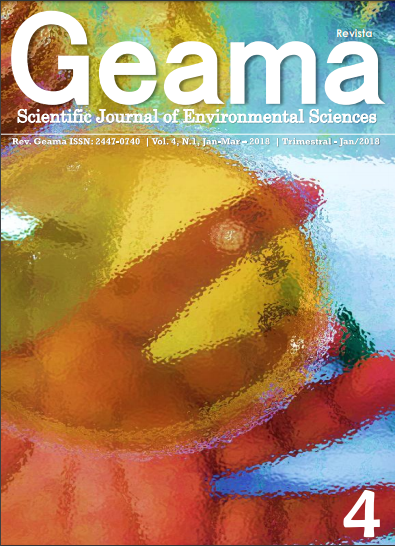Statistical evaluation of mathematical models for Salmonella typhimurium growth
Resumo
Food illness is a serious health threat and has significant economic consequences for people in both the developing and developed world. Salmonella genus is one of the most common pathogens and a major cause of foodborne illness in humans worldwide. Nowadays, the application of mathematical models and functions to describe the microorganism growth kinetics provides a new behavioral vision of the interaction between microorganisms and the environment. Lately the studies on the subject have been gathering interest in the elaboration and application of mathematical modeling and equations over the last years to be used in biotechnological and industrial process, therefore being a most useful tool, with the intent of reducing time and expenses associated with the conventional tests. The purpose of the present study was to compare the Baranyi and Roberts (1994) model with quadratic function generated from data experimentally obtained of the Salmonella typhimurium growth in vitro. It was observed that the quadratic function had a better fitting to describe the kinetics growth of Salmonella typhimurium, this function being a low cost, efficient and easily applied tool.Downloads
Referências
BARANYI, J.; ROBERTS, T.A.; McCLURE, P. A nonautonomous
differential equation to model bacterial
growth. Food Microbiology, v. 10, n. 1, p. 43-59, 1993.
BARANYI, J.; ROBERTS, T.A. A dynamic approach to
predicting bacterial growth in food. International
Journal of Food Microbiology, v. 23, n. 3-4, p. 277-294,
BARANYI, J.; ROBERTS, T.A. Mathematics of
predictive food microbiology. International Journal of
Food Microbiology, v. 26, n. 2, p. 199-218, 1995.
BASTI, A. A.; RAZAVILAR, V. Growth response and
modeling of the effects of selected factors on the timeto-detection
and probability of growth initiation of
Salmonella typhimurium. Food Microbiology, v. 21, n.
, p. 431-438, 2004.
CDC. Centers for Disease Control and Prevention.
Pathogens causing US foodborne illnesses,
hospitalizations, and deaths, 2000–2008. 2010.
Disponível em: <https://www.cdc.gov/salmonella/>.
Acesso em: 23 set 2017.
COGAN, T.A. Growth of Salmonella enteritidis in
artificially contaminated eggs: the effects of inoculum
size and suspending media. International Journal of
Food Microbiology, v. 70, n. 1-2, p. 131-141, 2001.
FDA. Food and Drug Administration, 2010. Food
Code. Available at Disponível em:
http://www.cfsan.fda.gov/~dms/fc01-pre.html>. Acesso
em: 15 set 2017.
GUPTA, R.; SHARMA, P.; VYAS, V.V. Effect of growth
environment on the stability of a recombinant shuttle
plasmid, pCPPS-31, in Escherichia coli. Journal of
Biotechnology, v.41, n. 1, p. 29-37, 1995.
LENHARD, J.; CARRIER, M. Mathematics as a Tool:
Tracing New Roles of Mathematics in the Sciences.
Boston: Springer, 154p, 2017.
LOPEZ, S.; PRIETO, M.; DIJKSTRA, J.; DHANOA,
M.S.; FRANCE, J. Statistical evaluation of
mathematical models for microbial growth.
International Journal of Food Microbiology,v. 96, n.3,
p. 289-300, 2004.
McDONALD, K; SUN, D. Predictive food microbiology
for the meat industry: a review. International Journal
of Food Microbiology, v. 52, n. 1-2, p. 1-27, 1999.
MEAD, P. S.; SLUTSKER, L.; DIETZ, V.; MACRAIG,
L. F.; BRESEE, J. S.; SHAPIRO, C.; GRIFFIN, P. M.;
TAUXE, R. V. Food related illness and death in the
United States. Emergency Infection Disease, v. 5, n. 5,
-625, 1999.
PERNI, S.; ANDREW, P. W.; SHAMA, G. Estimating
the maximum growth rate from
microbial growth curves: definition is everything. Food
Microbiology, v.22, n. 6, 491- 495, 2005.
ROBINSON, T. P.; ABOABA, O. O.; KALOTI, A.,
OCIO, M., BARANYI, J.; MACKEY, B.M. The effect of
inoculum size on the lag phase of Listeria
monocytogenes. International Journal of Food
Microbiology, v. 70, n. 1-2, p. 163-173, 2001.
SCHLEGEL, H. G. General Microbiology. (1st ed.)
Cambridge, UK: University Press, 154p, 1997.
SILVA, S. M.; SILVA, E. M.; SILVA, E. Matemática
Básica para Cursos Superiores. (1st ed.) Atlas: São
Paulo, 232p, 2002.
TORTORA, G. J.; FUNKE, B. R.; CASE, C. L.
Microbiologia. Porto Alegre: Artmed, 964p, 2017.
TRABULSI, L. R.; ALTERTUM, F. Microbiologia. Rio
de Janeiro: Atheneu, 2015, 912p.
VAM IMPE, J. F.; POSCHET, F., GEERAERD, A. H.,
VEREECKEN, K. M. Towards a novel class of
predictive microbial growth models. International
Journal of Food Microbiology, v. 100, n. 1-3, p. 97-105,
Vieira, S. Bioestatística: Tópicos Avançados. Rio de
Janeiro: Elsevier, 216p, 2004
Downloads
Publicado
Como Citar
Edição
Seção
Licença
As Políticas Culturais em Revista aplica a Licença Creative Commons Atribuição-Não Comercial 4.0 Internacional (CC BY-NC-SA 4.0) para os trabalhos que publica. Esta licença foi desenvolvida para facilitar o acesso aberto - ou seja, o acesso livre, imediato, e a reutilização irrestrita de trabalhos originais de todos os tipos. Nossos autores mantêm os direitos autorais mas, sob essa licença, concordam em deixar os artigos legalmente disponíveis para reutilização, sem necessidade de permissão ou taxas, para praticamente qualquer finalidade. Qualquer pessoa pode copiar, distribuir ou reutilizar esses artigos, desde que o autor e a fonte original (Políticas Culturais em Revista) sejam devidamente citados.
![]()






